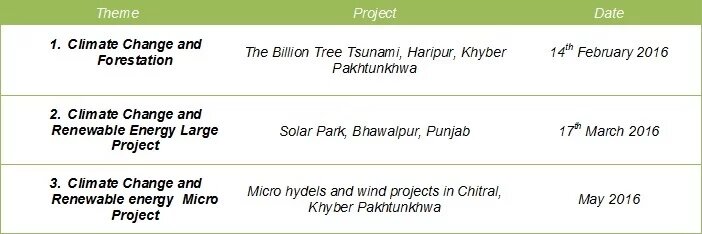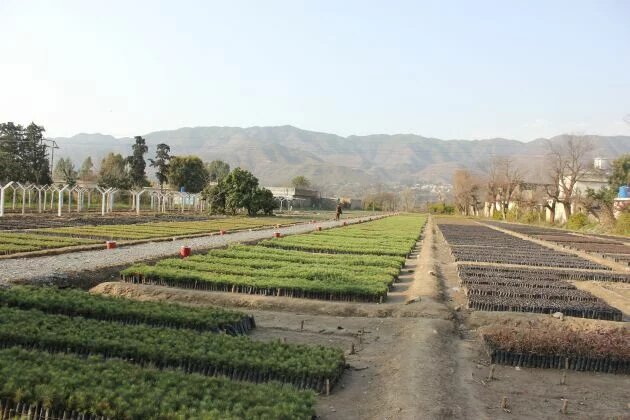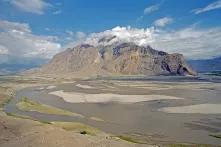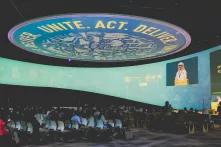
In the year 2016 exposure visits for journalists are taking place. They are taken to projects that are meant to mitigate or adapt to climate change such as renewable energy and reforestation projects. Location visits, meetings with involved communities and the project implementers provide the background for analyses and reporting back in the newspaper. Journalists likewise act as a watchdog and spread awareness to further promote climate-friendly initiatives.

Background: Heinrich Boell Stiftung (hbs) as part of the worldwide green movement believes in working with agents of change such as community, policy makers, media and civil society in order to bridge gaps at all levels. To foster cooperation and bringing forth a green agenda in the year 2015, hbs initiated workshops for journalists to orient them with national and international discourse on Climate Change and Climate Justice. In the run up to COP21 (December 2015), articles were written by many journalists on impacts of climate change in Pakistan and the state of policy making in this regard.
In the year 2016 exposure visits for journalists are taking place. They are taken to projects that are meant to mitigate or adapt to climate change such as renewable energy and reforestation projects. Location visits, meetings with involved communities and the project implementers provide the background for analyses and reporting back in the newspaper. Journalists likewise act as watchdog and spread awareness to further promote climate friendly initiatives.
The schedule for the project/location visits is as follows:
First exposure Visit: Climate Change and Forestation
Forest helps maintain the ecological balance by cleaning the atmosphere of green house gases and maintaining the temperature. It is the back bone for the survival of animals and biodiversity. Forest cut expels green house gases in the atmosphere which otherwise are stored by the trees thus leading to lack of mitigation capacity. Moreover the burning of the wood from forest emits green house gases. According to Valentin Bellassen et al. tropical deforestation is responsible for 15 to 20% of total man made emissions of green house gases. Other estimates show that 30% of global greenhouse-gas emissions each year is due to forest loss. More than 1.5 billion tons of carbon dioxide is released to the atmosphere due to deforestation, mainly the cutting and burning of forests, every year. Land degradation is also a result of deforestation.
In recent years reforestation has been recognized as a means to slow down climate change. The German Federal Ministry of Environment took an initiative called “Bonn Challenge” and were able to bring world Leaders together to consider reforestation for mitigating climate change. The Bonn Challenge also includes restoration of deforested and degraded land i.e.150 million hectares by the year 2020.
Pakistan has been ranked among the top ten countries threatened by climate change for the past 5 years. However the situation with regards to forest conservation is bleak. Ideally a country should have at least 20 to 25 percent of forest cover but in South Asia Pakistan is the country with least forest cover i.e. 5.2 percent besides the rate of deforestation is also very high. These practices are contributing to increase in the temperature thus making Pakistan more vulnerable to the impacts of climate change. The water reserves of Pakistan are also under threat and it is estimated that by 2035 Pakistan will be a highly water scarce country.
While the rest of the provincial governments are busy cutting trees, Khyber Pakhtunkhwa is running a campaign called- The “Billion Tree Tsunami”- since June 2015. The idea of the project is to plant 1 billion trees within 5 years. The “Billion Tree Tsunami” has also been recognized and registered by the “Bonn Challenge” and is being monitoring periodically.
According to Amin Asalm, Chairman of the Green Growth Initiative in Khyber-Pakhtunkhwa “The One billion tree Tsunami aims to restore the land degradation and forests in the province. The Pakistan government has promised 150 million dollars to the forest restoration efforts. For the first time in the history of Pakistan, the forest area in the province is targeted for a major enhancement from 20 percent to 22 percent by 2018, which would entail bringing new areas under forests as well as protecting and enriching the existing area. Thus, under the project, at least 30,000 hectares of additional forests will be planted through a massive a-forestation drive.” (The Express Tribune, 1st March 2015)
On 14th February 2016, Heinrich Boell Stiftung, Pakistan took 10 journalists from print and electronic media to several sites of “the Billion Tree Tsunami” in Haripur. The purpose was to highlight the link between climate change, deforestation and reforestation. They were first given an orientation on the importance of reforestation for climate change. The orientation was followed by site visit of nurseries, plantation sites and community involved in the Billion Tree Tsunami project. Journalists were given a chance to interact with the community to know community’s understanding, views and drive for the initiative.
The expressions recorded are presented in the following articles and reports prepared by the journalists.
Media Coverage
Pakistan’s ‘Billion Tree Tsunami’ gains momentum DAWN NEWS
Earthly matters: One billion trees DAWN NEWS
Power 99 Report on Billion Tree Project By Asma Sulman.mp3
Pakistan’s ‘Billion Tree Tsunami’ takes hold thethirdpole.net


